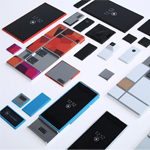
Google agreed to sell Motorola, but it turned out that the search engine giant was holding onto one organization within Motorola: the Advanced Technology and Projects (ATAP) group. Headed by Regina Dugan, the former director of the U.S. Defense Department’s fabled Defense Advanced Research Projects Agency (DARPA).
ATAP aims to bring the same approach to mobile-gadget innovation that DARPA used that started small but eventually mattered a lot.
Google's got plenty of things hiding under its sleeves. Brewing in its ATAP, is Project Ara, one of the most intriguing modular smartphone design. Because Ara's a platform designed to lets users swap out hardware (processors, cameras, sensors, etc.) on the phone, it presents unique opportunities for developers to build different kinds of modules and the software needed to make them all work.
The company already has another group devoted to such 'moonshots' efforts - Google X, which is working on Google Glass, broadband balloons and more - but ATAP, with the technologies and projects it specializes in is the reason why the company retained it.
Build for Customization
Project Ara, which aims to reinvent the smartphone by breaking it down into modules that can be assembled and customized in a limitless number of configurations. The company first disclosed that the project existed on October 29th, 2013.
It's a big dream; even for Google. But if Ara works as advertised and large numbers of phone buyers buy into the proposition, they could get something that contrasts sharply with the traditional breed of off-the-shelf phones released on a yearly schedule.
For instance, when Samsung announced the Galaxy S 5, it's highlighting improvements included a better camera, a fingerprint scanner and a heart-rate monitor. In a world of modular phones, people will be able to pick any or all of those features and add them to other phone. People can also pick among multiple cameras, or even choose features that are not meant for the masses.
The modularity concept resurfaced in 2008 with phones from Israeli startup Modu that made a credit card-sized micro-handset could slip into different cases for different purposes. But the idea didn't fit well to the masses, and Modu folded because of financial problems. The company ended by selling its patents to Google.
The DARPA/ATAP involves small in-house teams, being given a few years to tackle the ambitious challenge. Most of the things are done by external factors of Google: individuals, companies and universities that contribute to the project on a contractual bases as necessary, either for a brief moment or for a long haul. One key external performer is NK Labs
Another vital contributor to the effort is 3D printing. Google aims to develop a new high-speed continuous 3D printer capable of cranking out enclosures for Ara modules in volume, allowing for phones to be both mass-produced and custom-designed in a way that's new for any consumer product.
What the Ara team and its outside contributors have created is a platform that supports three sizes of phone: mini (basic), medium (mainstream) and jumbo (phablet-style variant). The size of each is determined by its aluminium endoskeleton that contains a networking circuitry so the modules can talk to each other - the one component of an Ara phone that will be Google-branded.
Ara's screen to precessor and battery is provides in the form of a module - a medium endoskeleton has a space for ten - which users can slide into place to form a phone. the first prototype's modules use retractable pins to connect to the endoskeleton’s network.
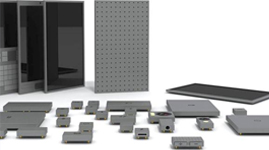
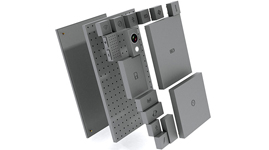
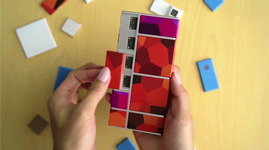
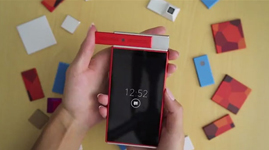
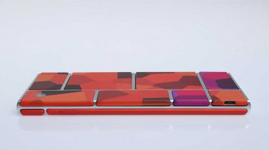

The Plug and Play Module
Similar to the expansion slots on a desktop PC's motherboard, each compartment on the endoskeleton is designed to handle any module of the correct size, regardless of its function. Though basic technical issues are sometimes a factor - for example, an antenna can't be placed randomly on a phone's body - the general idea is to design the phone so that people can swap modules in and out at will.
And with the networking circuitry that is powered by individual batteries inside each modules, Ara is designed to permit hot-swapping of modules, without requiring users to power down the phone. Users can also fit multiple battery if needed and if the space inside the endoskeleton permits.
Standard equipements on smartphones such as camera, speakers and so forth, are presented by modules. This makes Ara a customizable phone with the ability of personalization. Other modules could offer more specialized capabilities.
Ara's modules are securely latched to the endoskeleton and equipped with electropermanent magnets, making it less prone to "fall apart" when it falls.The phone is also meant to be resistant to water and other environmental threats.
However good it can be, the detachable modules create space issues. When Apple designs an iPhone, it's able to cram in parts to the tightest place possible. But when Ara comes with modules, the hardware loses that advantage.
"A big challenge on this project was that a cellphone is one of the most integrated things that's made today, and we're trying to separate it into modular pieces," said Ara Knaian, NK Labs co-founder, one of ATAP's external contributor. "And so the challenge was how to fit everything in an efficient way, so that people could have the ability at home to add and remove modules and have a lot of flexibility about what modules they put in, but not to have too much added weight or too much added cost by doing that."
Keeping the size reasonable was crucial. "When people say 'modular phone,'" explained Paul Eremenko, a DARPA alumnus, "the first thing that jumps to mind is, like, Legos - a big, blocky thing. And so we had to overcome that with the industrial design. That was the first mental hurdle to overcome."
Inserted into an endoskeleton, the modules form a phone that’s 9.7mm thick in its current prototype form.
Eremenko said that he had the luxury of focusing on making sure Ara is great, not profitable: "This is potentially the only thing out there that could turn into a five-billion-unit kind of device. The fact that that will accrue benefits to Google downstream is so obvious that I don’t have to make a business case."
The first expression of the modular concept Ara's creators are focusing on is a smartphone with a target price of $50.
Besides Project Ara, efforts under ATAP include Project Tango, an experimental smartphone that can map the world around it.